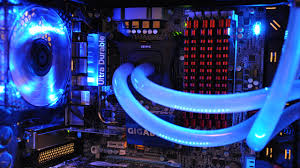processor overclocking to mining
WARNING !!!
the chances of burning the processor, memories and even the motherboard are great.
depending on the overclock, you will need to purchase coolers or other cooling systems.
Clock - is the internal speed of the processor, measured by the speed of the FSB (seen below) times the value of the multiplier, which is defined by the BIOS;
Clock cycles - consists of the time intervals the processor uses to execute its instructions;
FSB - stands for Front Side Bus and has the function of defining the external speed of the processor, that is, the speed at which the processor communicates with the memory and components of the motherboard. The FSB speeds are as follows: 100 MHz, 133 MHz and 166 MHz. Higher values usually exist, but are generally generated by multiplying these quoted;
Vcore - is the equipment voltage.
To overclock, you need to work with the BIOS Setup settings, usually accessible by pressing the delete button as soon as the computer is turned on. Depending on the brand of your computer, access to the Setup can be done through another key. Consult the manufacturer's manual or support if you are not able to access Setup from your computer.
When you enter Setup, you will see a series of items. Look for one that deals with the processor. Generally the name of this item is or looks like "Processor Settings" or "CPU Setup" or "Features Setup". When you can enter this item, a value multiplied by another will appear. This is the FSB x multiplier = clock operation, where multiplier is a numerical value. Note that the value resulting from this multiplication is the processor clock value. Now let's overclock. We will use as an example an overclocking performed on a 1.6 GHz Pentium 4. Its FSB x multiplier configuration is:
100 MHz x 16 = 1.6 GHz or 1600 MHz
For overclocking, the FSB has been changed to 133 MHz (you can usually change this value using the arrow keys or the Page Up and Page Down buttons on your keyboard):
133 MHz x 16 = 2.1 GHz or 2.128 MHz
Remember, your computer's FSB may be in another value. If it is at 400 MHz for example, it is multiplied by 4 (100 MHz x 4 = 400 MHz). In the example, the performance gain is notorious. The 1.6 GHz Pentium 4 jumped to 2.1 GHz.
Now let's show an example on an Ahtlon XP 1600+ MHz processor. In fact, this processor operates at 1,400 MHz, but AMD has a + symbol to say that the model, even operating at 1,400 MHz, equates to a Pentium 4 of 1,600 MHz.
In our example, this processor works in the following configuration:
133 MHz x 10.5 = 1.4 GHz or 1,396.5 MHz
Changing the FSB from 133 to 166 MHz, the result is:
166 MHz x 10.5 = 1.7 GHz or 1743 MHz
GREAT MINING
Nice post! Follow you!
i'm toghether